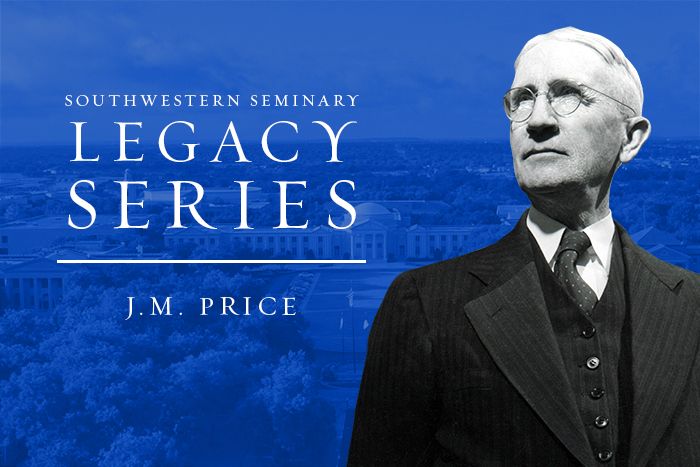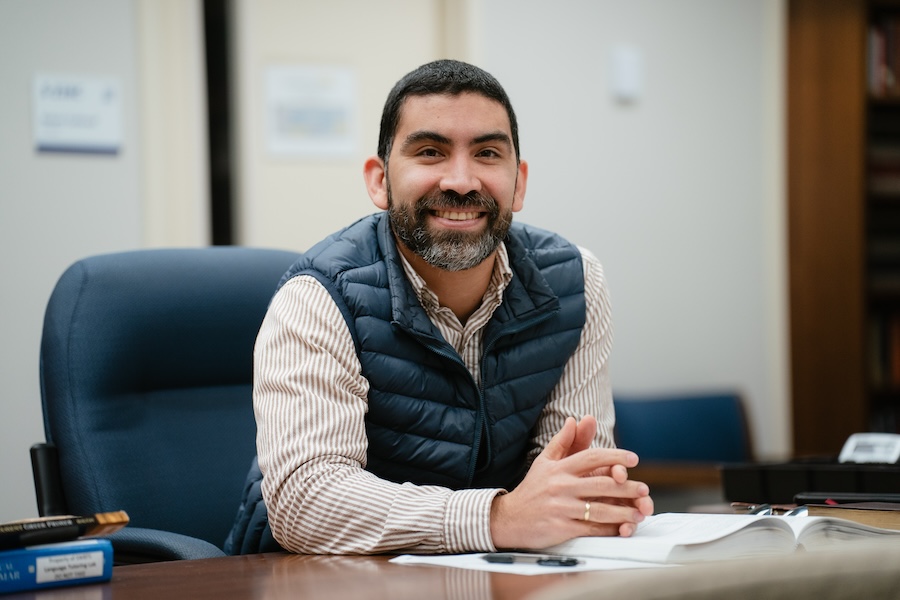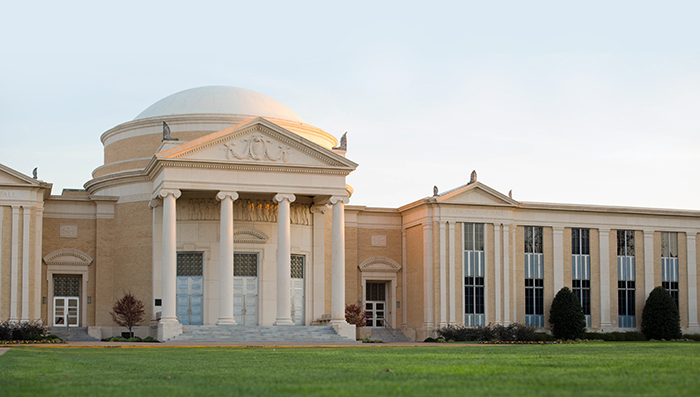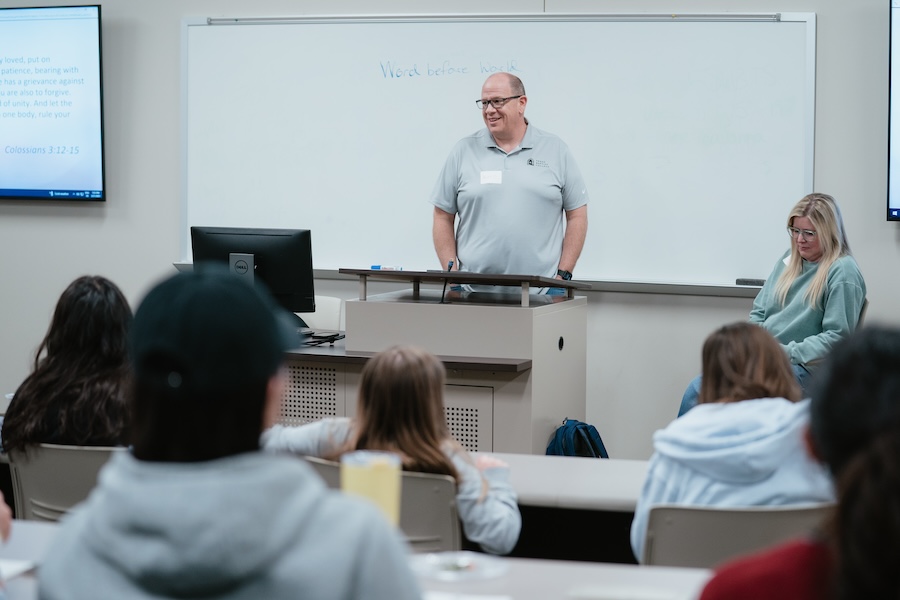SWBTS Legacy: J.M. Price


J.M. Price was nearing the end of his master of theology program in Kentucky when he received a letter from L.R. Scarborough, the new president of the young Southwestern Baptist Theological Seminary. Scarborough had written to offer Price a professorship at the seminary, and he outlined a vision for the seminary’s endeavors in the area of Christian education and pedagogy. Scarborough was looking for a pioneer who had the drive and vision to establish a school unlike any other.
“It is now our purpose to establish a School of Christian Pedagogy,” Scarborough wrote. “I think we have hold of the small end of a big proposition. We will have to do pioneer work and break new ground.”
“As I understand it,” Scarborough continued, “this school of pedagogy will be a rare thing in this country, the only one in the South and even beyond the South. The Sunday School Board men are very enthusiastic about this movement and believe that it is one of the most distinctive and far-reaching kingdom matters started within many years.”
Price carefully considered the offer. He had already envisioned popularizing Bible study among the masses, and he wanted religious education to be not just for pastors, but for Sunday School teachers, laymen, and everyday church members. Price envisioned rural farmers, mothers, and laborers who knew why they believed what they believed, and were trained to teach that knowledge to others.
Although a monumental assignment lay before him, Price believed it was the beginning of the life work to which God had called him. His move to Fort Worth, Texas, would set into motion his groundbreaking work at Southwestern Seminary for both the institution and the broader Southern Baptist Convention. His list of accomplishments and “firsts” are evidence of a visionary-pioneer leader and educator who would have a lasting impact on how churches promoted the Kingdom of God.
‘The Greatest Force for Good’
John Milburn Price was born on Nov. 21, 1884, on a farm near Fair Dealing, Ky. The youngest of eight children, Price was named after the prominent preacher J.H. Milburn, a visiting preacher whose sermon ultimately led Price’s mother, Elizabeth, to give her life to the Lord.
Price’s parents were both great influences in his life, responsible for many of the characteristics that made him the great leader he was. Many would attest that, like his mother, Price’s tenacity and determination were central to his success in a pioneering task.
Even at a young age, Price had a deep respect for Sunday School and the way in which it could influence students. The role of teacher held immeasurable possibilities. He often said that he considered Sunday School teachers to be “the greatest force for good in the nation.”
At the age of 18, Price began teaching at a school near the Price farm, teaching 37 pupils in wide-ranging subjects and grade levels. During that time, he also began studies for the undergraduate degree he would complete in 1905 at the age of 20.
A New School Emerges
Price’s ministry eventually led him to the Southwestern Baptist Theological Seminary, where he had been called upon to build a school of religious education from the ground up.
Price joined the seminary faculty in 1915 and hit the ground running. But the task did not prove easy at first. When the other new professor, I.E. Reynolds, shared with Price his enrollment numbers for the new music program, Price became discouraged.
People seemed eager to join the new music program, but Price had only two students in the education program. Enrollment numbers were an indication of the novelty of such a program—there was little for Price to model in this area of study.
At the time, the only other school of religious pedagogy in the country was in Hartford, Conn., but the Hartford school had no denominational association, and Price wanted to train Baptists to do work in Baptist churches. Other seminaries offered single courses in pedagogies, but they primarily existed to train pastors.
Additionally, churches were not yet looking for educational leaders in their churches and staffs. In 1915, only four Southern Baptist churches had educational workers.
Even still, Price set out to create a curriculum that, while beneficial for pastors, would train other men and women for their purposes in the church.
As Price reflected on the task before him, he said, “All former experience in training for religious education must go on the scrap heap. My school must be on a bigger and better scale. I might as well face it: I must blaze a new trail in religious education.”
With a newly established religious education curriculum and a newly hired faculty, the education department saw a steady growth in its first few years. In 1919, its first graduate, Lou Ella Austin, received a diploma in Religious Education.
That same year, Price made more pioneering steps at Southwestern Seminary. He created age-specific courses, including elementary, adolescent, and adult religious education. Additionally, students admitted to the Doctor of Theology program were allowed to major in religious education.
By 1920, student enrollment in the new school had increased to 121 students from 16 states. Price had established a three-year curriculum that would lead to the Master of Religious Education, and he began to hire more experienced faculty in their respective fields.
Price established many more “firsts,” including the creation of departments devoted to more specific disciplines such as principles of religious education, administration, and church efficiency.
Every decision Price made was groundbreaking simply for its novelty. No other seminary had devoted such time and resources to religious education, offering practical field study while maintaining the academic rigor expected of a theological education.
With an evolving School of Religious Education, more churches began to see the results from this pioneering work. They began to hire educational ministers and put an emphasis on their Sunday School programs. Churches built new structures with this in mind, allowing for more classroom space than ever before.
Price Hall
As early as 1925, Price wanted a building to house the School of Religious Education. Price even had sketches drawn for the vision. It would be another 20 years before that would be set into motion, but he was patient and persistent.
At the time of the proposed construction of the Memorial Building in the early 1940s, Price was determined to also see the construction of the education building. Due to his diligence, the project was approved, and Price spearheaded the fundraising efforts for the building.
Finally, in 1949, the long-awaited building was opened and named in honor of the school’s founder and leader. Price Hall was the first of its kind. No other institution had constructed a building for the purpose of training laymen, Sunday School teachers, and ministers of education.
His Lasting Influence
Although such educational programs and ministry focuses were nearly nonexistent at the beginning of the 20th century, they soon became the standard thanks to Price and the work he did at Southwestern Seminary. The demand quickly outpaced the rate at which the seminary could train students. Even pastors, who had otherwise been skeptical of these programs, were convinced of the need to take classes in religious education to better lead the laymen of their congregations.
When Price retired in 1956 at the age of 71, he had served under presidents L.R. Scarborough, E.D. Head, and J. Howard Williams. He had led the School of Religious Education for 41 years, teaching longer than any other Southwestern Seminary professor at the time. In a two-page spread of the 1956 issue of Southwestern News, a list of all his accomplishments and “firsts” outlined the story of a man who pioneered a new trail in theological and religious education at Southwestern Seminary, the SBC, and even other religious institutions. Some of these “firsts” included: first in America to offer a religious education diploma (1917); first in requiring supervised fieldwork as a requirement for a degree (1920); and first school of religious education among Southern Baptists to be accredited (1951).
Even after retirement, Price held the title of director emeritus of the school and retained his office in Price Hall, where he continued writing, studying, and counseling students and professors in their work. To the end of his life, he remained determined to see generations trained for their individual callings.
After recounting stories and experiences with Price, one former student concluded, “I hope we remember the principles and methods he taught us as well as we remember his stories. I suppose he has trained more educational directors than any other man, living or dead.”
By the time Price retired, many men and women had graduated from his pioneer program, adopted his ideas and methods, and were making it their life’s work to blaze new trails in their own churches for the glory of Christ and to further the Kingdom of God.



